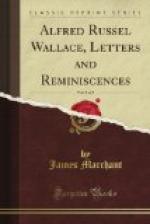In reading his books and essays written more than seventy years later, we are struck with the exceptional opportunities which he had of comparing social conditions, and commercial and individual prosperity during that long period, and of witnessing the introduction of many inventions. He used to enjoy recalling many of the discussions between intelligent mechanics which he heard of in his early days regarding the introduction of the steam-engine. One and another declared that the grip of the engine on the rails would not be sufficient to draw heavy trucks or carriages; that the wheels, in fact, would whiz round instead of going on, and that it would be necessary to sprinkle sand in front of the wheels, or make the tyres rough like files. About this time, too, there arose a keen debate upon the relative merits of the new railroads and the old canals. Many thought that the former could never compete with the latter in carrying heavy goods; but facts soon proved otherwise, for in one district alone the traffic of the canal, within two years of the coming of the railway, decreased by 1,000,000 tons.
It was during these years, and when he and his brother were making a survey for the enclosure of some common lands near Llandrindod Wells, that Wallace finally became aware of the injustice towards the labouring classes of the General Enclosure Act.
In this particular locality the land to be enclosed consisted of a large extent of moor, and mountain which, with other common rights, had for many years enabled the occupants of the scattered cottages around to keep a horse, cow, or a few sheep, and thus make a fairly comfortable living. Under the Act, the whole of this open land was divided among the adjacent landowners of the parish or manor, in proportion to the size or value of their estates. Thus, to those who actually possessed much, much was given; whilst to those who only nominally owned a little land, even that was taken away in return for a small compensation which was by no means as valuable to them as the right to graze their cattle. In spite of the statement set forth in the General Enclosure Act—“Whereas it is expedient to facilitate the enclosure and improvement of common and other lands now subject to the rights of property which obstruct cultivation and the productive employment of labour,” Wallace ascertained many years later that no single part of the land so enclosed had been cultivated by those to whom it was given, though certain portions had been let or sold at fabulous prices for building purposes, to accommodate summer visitors to the neighbourhood. Thus the unfortunate people who had formerly enjoyed home, health, and comparative prosperity in the cottages scattered over this common land had been obliged to migrate to the large towns, seeking for fresh employment and means of subsistence, or had become “law-created paupers”; whilst to crown all, the piece of common originally “reserved” for the benefit of the inhabitants had been turned into golf-links!




